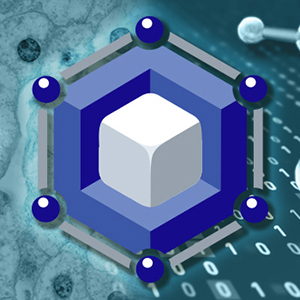 Rick Woychik, Ph.D., directs NIEHS and the National Toxicology Program. (Image courtesy of NIEHS)
Rick Woychik, Ph.D., directs NIEHS and the National Toxicology Program. (Image courtesy of NIEHS)Artificial intelligence, biomonitoring technology, and fruit flies are key aspects of an exciting new effort to improve toxicity testing and boost knowledge about how environmental chemicals might influence neurodevelopmental disorders. Dondrae Coble, D.V.M., chief of the NIEHS Comparative Medicine Branch, and Jesse Cushman, Ph.D., director of the institute’s Neurobehavioral Core Laboratory, are leading the project. The initiative is supported through a National Institutes of Health (NIH) Director’s Challenge Innovation Award.
First, the team will study how a variety of chemicals might affect the behavior of fruit flies, which are commonly used in biomedical research because they are inexpensive, reproduce quickly, and share genetic similarities with humans. The scientists will try to determine which of those substances are most likely to cause neurodevelopmental issues, and then they will test the chemicals in mice. The researchers seek to assess commonalities and differences in behavior between the fruit flies and mice, and they will compare their findings to relevant effects in humans. This “cross-species extrapolation model” could help to lower research costs, reduce the use of animals, and improve data collection and interpretation.
Machine vision, which involves using biomedical imaging tools aided by artificial intelligence and machine learning, is an important part of the project. Such technology will enable scientists to track behavioral changes continuously in the fruit flies and mice. This is unlike traditional behavioral monitoring, which is labor-intensive and requires someone to watch the model organism, take extensive notes, and so forth. Machine vision will produce a wealth of robust behavioral data that could open the door for groundbreaking discoveries.
Recently, I spoke with Coble and Cushman to learn more about this project, which involves experts across the National Institutes of Health (NIH). In addition, I asked both scientists to discuss what inspired them to pursue biomedical careers (see sidebar). Excerpts of our in-depth conversation are provided below.
Fruit flies and machine vision
Rick Woychik: Congratulations on winning the NIH Director’s Challenge Innovation Award for your project, “Machine vision-enabled behavioral tracking for cross-species extrapolation.” Can you provide Environmental Factor readers with background information on this effort?
 Coble is a diplomate of the American College of Laboratory Animal Medicine, a certified aquatic veterinarian, and an ad hoc specialist for the Association for Assessment and Accreditation of Laboratory Animal Care International. (Photo courtesy of Steve McCaw / NIEHS)
Coble is a diplomate of the American College of Laboratory Animal Medicine, a certified aquatic veterinarian, and an ad hoc specialist for the Association for Assessment and Accreditation of Laboratory Animal Care International. (Photo courtesy of Steve McCaw / NIEHS)Dondrae Coble: We are very excited about this project. It is a collaborative effort that involves the NIEHS Division of Intramural Research, the NIEHS Division of Translational Toxicology [DTT], the National Institute of Biomedical Imaging and Bioengineering, and the National Institute of Diabetes and Digestive and Kidney Diseases [NIDDK].
We will first use Drosophila, or fruit flies, to assess chemicals being studied by DTT for their potential neurodevelopmental effects. We want to identify the substances most likely to cause such effects and then move to a higher-order model, a mouse model, for further testing.
The project involves the novelty of machine vision, which we hope will help us compare behavioral measures between the fruit flies and mouse models. Going forward, if we find that the Drosophila model provides us with scientifically useful information on neurodevelopment, we will be able to reduce our use of mice and lower research costs, among other benefits.
I joined NIEHS recently, in October 2021, so I want to point out that Jesse and Dr. Brian Berridge, scientific director of DTT, laid the groundwork for this project prior to my arrival. Their efforts helped me jumpstart collaborations that will be vital to our success.
Jesse Cushman: This project came together at the right time and the right place, and Dondrae helped to bring these different groups together and really push it forward.
In my view, when it comes to studying behavior, we are in the midst of a revolution in machine vision, where technology from applications like self-driving cars is spurring major innovation. Machine vision enables researchers to process visual information in incredibly sophisticated ways, and it has opened up a whole new approach for studying behavior.
 Cushman serves on the steering committee of the NIEHS Faculty for Advancing Neuroscience Cross-Divisional Group, which aims to advance research into how environmental exposures might influence brain health and disease. (Photo courtesy of Steve McCaw / NIEHS)
Cushman serves on the steering committee of the NIEHS Faculty for Advancing Neuroscience Cross-Divisional Group, which aims to advance research into how environmental exposures might influence brain health and disease. (Photo courtesy of Steve McCaw / NIEHS)Traditional behavioral studies involve placing rodents in some sort of specialized apparatus, observing them for a short period because of limitations of human time and effort, and then putting them back and completely ignoring them. Now, sophisticated algorithms can help us better visualize and categorize what they're doing, and we can do this 24/7, at scale.
Behavior reveals fundamental insights
RW: What are the benefits of studying behavior?
JC: Behavior is kind of the highest-level output of the organism. Generally, what gets us as humans to go to the doctor is some sort of behavioral change or noticing a change in our body, and that is important when we start thinking about using animals as models of humans. Everything that's going on in the animal, if it's a significant enough change, you're going to be able to detect at the level of behavior.
DC: Speaking from a veterinary standpoint, we often use behavior as an indicator of welfare. For example, post-operation, there are important things that you can observe, such as the grimace scale for mice and rats. Or we could look at something such as the direction or shape of the whiskers. Also, the nesting behavior of mice can be an indicator of health and wellbeing. So, often, we use behavior as our guide for overall welfare and identifying treatments for animals.
On the lookout for neurodevelopmental effects
RW: You are focusing on neurodevelopmental deficits resulting from chemical exposures. How will you know whether fruit flies or mice are exhibiting such deficits?
DC: Regarding fruit flies, I'll give my disclaimer that I'm definitely not a Drosophila expert [laughs]. We are collaborating with our colleagues from NIDDK, and they are the fruit fly specialists on this project. That said, there are in fact autism models for fruit flies. For example, it has been shown that their decision making can be impacted, which can affect their flight pattern, the frequency of their turns, and so forth.
JC: There are many ways to study autism in mice. For example, we know they are very social. A normal mouse prefers to interact with a new mouse that it has never met. In severe autism-like cases, mice lose their tendency to want to interact with a new mouse. In more subtle cases, they will be introduced to a second new mouse but continue to interact with their old friend, which can indicate an inability to distinguish other mice.
Machine vision will be very helpful in understanding mice behavior following chemical exposure. In traditional approaches, if mice are free to run around and interact with one another, annotating such behavior becomes very difficult. Our hope is that through machine vision, we could have perhaps two, three, or four mice living together. Then we can keep the identity of each of those mice separate across time while assessing how each of them interact. We think that will provide us with a lot of useful information about potential neurodevelopmental effects.
All-hands-on-deck approach
RW: Is there anything else about this project that you would like to share with Environmental Factor readers?
DC: Speaking again from my perspective as a veterinarian, biomedical research is highly regulated, and there are many protocols that we follow. My job is to make sure we’re following those rules and that our science is as strong as it can be so that we can make greater strides in our understanding of neurodevelopmental disorders. I look forward to the challenge.
JC: We want to make our data available to anyone who wants to help us advance the science in this area, so we’re following the FAIR principles of findability, accessibility, interoperability, and reusability. A major task will be to interpret that information, and that is where artificial intelligence and cutting-edge data science will come into play. There are many challenges ahead, but I believe that collaboration and an all-hands-on-deck approach will help us achieve success.
(Rick Woychik, Ph.D., directs NIEHS and the National Toxicology Program.)









